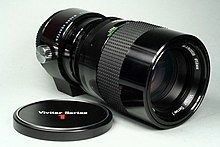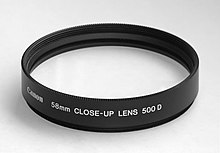Macro lens

A macro lens is a special interchangeable lens that makes it possible to achieve a large image scale - such as 1: 2 (image on the film or the sensor is half the size of the object itself) or 1: 1 (object becomes shown in original size on the film / sensor). One then speaks of macro photography .
Macro lenses also differ in their optical construction and imaging properties from conventional lenses with a similar focal length. In the construction, attention is usually paid to a particularly low curvature of the image field, uniform sharpness over the entire image field and low distortion.
Older constructions of macro lenses use a special mechanical mount, which, like a bellows device, allows infinitely variable extension. Modern models and in particular zoom lenses with macro functions, as they are also built into many digital compact cameras, mostly work according to the principle of internal focusing . The mechanical extension and thus the overall length change only slightly, but the focal length does not remain constant when focusing.
Conventional camera lenses achieve maximum image ratios in the range from 1: 7 to 1: 9, regardless of whether it is a fixed focal length or a zoom lens . Lenses that achieve an image scale of around 1: 4 are also often referred to as macro-capable.
The larger image scale is achieved by a greatly enlarged extension , by changing the focal length, by shifting the inner lens elements or by a combination of these two measures.
Typical properties
Normal photo lenses are optimized for the imaging of distant objects. The imaging performance usually drops significantly at short distances, especially the image field-dependent errors ( astigmatism , distortion , image field curvature ) increase, which among other things leads to strong edge blurring. This limits the minimum object distance if you want to get a useful result. A real macro lens is characterized by the fact that it has been designed for the best imaging performance with small object distances.
A macro lens usually has a smaller initial opening (i.e. a higher f-number ) than a normal lens. This reduces the image errors and increases the depth of field , which decreases reciprocally with the distance from the object.
Most manufacturers offer universal macro lenses with a focal length of 40 to 100 mm for small format cameras or digital SLR cameras, in some cases with a smaller focal length. Macro lenses with a focal length of 180 or 200 mm are also available for a larger distance between the object and the lens. The maximum achievable image scale of these lenses is usually 1: 2 or 1: 1, whereby some designs cover the range between 1: 2 and 1: 1 with the help of an additional close-up lens or an intermediate ring.
In terms of image quality, these lenses are generally also well suited for recordings with the usual shooting distances. However, there are some restrictions compared to standard lenses of the same focal length:
- The maximum light intensity is usually lower.
- Because of the more elaborate version, the size and weight are usually higher.
- The autofocus works much slower because of the much larger adjustment range. Some models therefore offer a possibility to limit the setting range,
- Both with autofocus and with manual setting, due to the steep adjustment curve, incorrect focusing can occur more frequently at greater distances.
Special macro lenses
One of the first macro lenses in the 1950s was the Opton Proxar from Zeiss-Oberkochen (focal length 32 mm) with an image scale of up to about 1: 1.
Venus Optics offers a lens with a maximum magnification factor of 2: 1, the Laowa 60 mm f / 2.8 Ultra Macro. It is for various full frame - bayonet connections available.
A special lens introduced by Minolta in the early 1990s , the Minolta AF Macro Zoom 3 × –1 × (1: 1.7–1: 2.8), achieves a reproduction ratio of 3: 1.
Magnifying lenses like the Canon MP-E 2.8 / 65 (scale 1: 1-5: 1), the Laowa 25 mm f / 2.8 Ultra Macro (Venus Optics, scale 2.5: 1-5: 1) and the Mitakon 20mm f / 2 ( Zhongyi Optics , scale 4: 1-4.5: 1) offer even higher maximum image ratios. They cannot be focused at greater distances or infinitely, but can only be used in macro photography .
The macro lens with the largest angle of view currently is the Laowa 15 mm f / 4 Wide Angle Macro from Venus Optics. Due to the small focal length, the depth of field is relatively large or the blurring outside the sharp area is relatively small. Objects can therefore be mapped well together with their surroundings, which is hardly possible with conventional macro lenses. The disadvantage of the short focal length is a relatively short working distance .
Alternatives
Close-up lenses
The macro adjustment options offered today with many zoom lenses are usually an inadequate compromise. A simultaneous correction of the image errors for several focal lengths and different object distances is difficult to achieve, whereby the macro image sharpness of a zoom lens is in practice considerably below the optical potential of a fixed focal length macro lens.
Instead of an expensive macro lens, you can also use a close-up lens . The image quality essentially depends on the quality of the close-up lens. An achromatically corrected close-up lens allows very high image quality.
Distance increase
Another possibility is to increase the distance between the lens and the image plane using a bellows device or intermediate rings. The image quality essentially depends on the behavior of the lens on the strongly shifted focal plane. Gauss types usually react relatively good-naturedly, zoom lenses and pronounced retrofocus lenses usually react with a sharply reduced image quality up to the complete lack of a focus plane. The beam path is then far outside the optimized beam passage through the objective. The high extension makes the image errors of a lens not designed for close range clearly visible.
The disadvantage of close-up lenses and spacer rings is that the adjustment range is not stepless. A set of close-up lenses of different refractive power or a set of intermediate rings of different lengths are therefore required for different magnifications.
Retro position
If the reproduction ratio is greater than 1: 1, the lens should be used in the so-called retro position. This inverts the beam path and avoids a further distance from the standard beam path. A reversing ring is required for this, in order to attach the lens with the filter thread to the camera or the intermediate rings or the bellows device. This reversing ring completely robs the lens of all automatic functions, in particular the autofocus function and the control of the diaphragm. In the case of lenses with manual iris control, the iris can be set specifically by hand. Lenses with electronic aperture control do not allow manual adjustment of the aperture in the retro position. Before removing the lens from the camera housing, a fixed aperture can be preset electronically if necessary. Reversing rings are available for some systems, which enable the spring diaphragm function via a special adapter.
Magnifying lenses
Lenses of enlargers can be used in macro photography via special adapters.
Microscope objectives
Microscope objectives can be coupled to a camera housing via adapters and thus used as magnifying lenses.
Depth of field
The small depth of field in the macro and micro range initially suggests a strong stopping down in order to generate the greatest possible depth of field. On the other hand, depending on the image scale, disruptive diffraction blurring occurs from a certain f-stop , so that a compromise has to be found depending on the application (see useful aperture , critical aperture ). Consistent depth of field can be generated using the focus stacking technique .
Extension factor
The amount of light from photographic lenses is basically calculated on an infinite distance setting. As the image scale increases, less light hits the sensor or film with a given aperture setting. This effect is practically irrelevant for normal photography, but is sometimes very noticeable in macro photography. The effect is due to physics and is independent of the type of lens. The effective aperture then no longer corresponds to the information on the aperture ring. The effective aperture can be calculated with the extension factor.
The extension factor depends on the image scale and can be easily calculated. At a reproduction ratio of 1: 1 it is 4 (four times the exposure time corresponding to two f-stops), at 10: 1 it is 36 (36 times the exposure time corresponding to 5.2 f-stops).
Trivia
In contrast to other providers, Nikon calls its macro lenses "Micro Nikkor".
Individual evidence
- ↑ Andreas Hurni, The Dark Side of Macro Photography ( Memento from October 11, 2019 in the Internet Archive )
Web links
- Database of older, rare or special macro lenses , Dr. Klaus Schmitt, accessed on November 15, 2019






